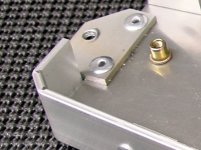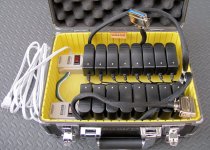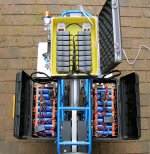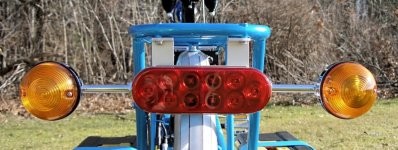Aluminum Fabrication
The aluminum fabrication in this build went fairly easily, taking advantage of a few larger power tools to speed the basic operations and to eliminate time-consuming hand finishing. None the less, everything could have been fabbed using hand and small power tools with a bit of patience. YouTube and the net are filled with aluminum HowTo pieces, but here’s a few notes on the simple techniques used here…
Material
The new components are constructed of simple 1/16” and 1/8” extrusions: channel, angle, and flat bar stock. Most are the anodized hardware store variety but a couple of sticks came from eBay with a plain mill finish. All plate was cut from a single 12x24” sheet of 1/8” 5052-T6 from eBay – more than enough for this job. If you are fabbing something similar using hand tools, you may wish to use thinner aluminum sheet to make life easier (1/16” or 3/32” instead of 1/8”).
Cutting
A table saw (DW744) and compound miter saw (DW703) sharing a Freud LU77M010 non-ferrous blade made all the slicing and dicing quite effortless. This blade is about $70, but cuts 1/8” aluminum like butter and leaves a clean polished edge that needs no additional dressing. Sheet stock much thinner than 18ga will need a sacrificial wooden backing of ¼” plywood or similar to lend rigidity and avoid blade grabs. An occasional spray/wipe of cutting oil keeps the blade lubed (Google ‘CRC cutting oil’).
This blade is very cool and allows fabrication normally requiring a shear and metal brake (see below).
Tiny pieces (of extrusion) are difficult to drill or otherwise work with any accuracy – even more so when using power tools like these that were designed for framing houses

. I find it easiest to first rip the stock to the proper width for a few inches (e.g. use the table saw to rip 1x1” angle to 1/2x3/4” angle) and then trim out the unused scrap width. Next lay out and drill the needed holes using the unripped extra stock for clamping, etc. Finally, use the chop saw to slice off the finished piece. When making multiple clips or small pieces, rip a longer piece of stock then lay out and drill all parts leaving extra space between the pieces. In the final step, trim each piece in the chop saw before cutting off the piece proper. This eliminates accumulated layout errors – the wasted stock is inconsequential and the resulting accuracy is limited only by the tool, not your layout skills.
Bending
There are a few bends in the build (dashboard and skirt for electrical panel). These are not necessary and could be eliminated, however, with the Freud blade it is simple to do very nice ghetto bends without a metal brake by cutting halfway through the material along the bend line and then folding the stock by hand. This works perfectly for bends up to about 45 degrees at which point the edges of the kerf collide. For steeper (90 degree) bends, run a kerf down the bend line as above and then run an adjacent overlapping kerf a bit shallower to widen the overall kerf by about 75%. When you fold the plate, it will follow the deeper cut giving a nice straight bend, and the shallower cut to the side will allow a greater bend angle before the kerf edges meet. Slightly different treatment is necessary according to the ratio of plate thickness to kerf width. A sheet metal seamer is handy for bending the plate but is not necessary (Harbor Freight/Google ‘sheet metal seamer’).

Clearly this technique compromises the strength of the plate, but all bends in this project are cosmetic and the plate itself is far thicker than necessary so the 1/16” material left in the bend is still quite strong. In other situations, you can bridge the kerf with a fillet using HTS-2000 low temp brazing rod. I’m not a big fan of HTS-2000 for fabrication (vs. repair) but if you take the time to learn technique, it works pretty well.
Drilling
Not much to say – I used a drill press which made the work easier and more accurate. It was, however, not strictly required except for the counterboring – which could have been avoided with some other small changes to the build. In any case - clamp when drilling and use rubber pads on your clamps (or wooden blocks) to avoid marring the work (Google ‘clamp pads’).
Holes 3/8” and up are easily made using a stepped bit. Harbor Freight (‘step drill’) sells a couple of different bit sets that are similar to Unibits and will last a long time drilling aluminum. These bits do not grab and are easy to control. Lube freely while drilling.
Counterboring for pop rivet heads and rivet nut flanges is a bit problematic because the bottom of the counterbore should be flat which cannot be accomplished with ordinary twist drills -- and counter bores are a bit pricey. However, Dewalt sells a line of modestly priced bits with pilot drills ground into the tip (Google ‘Dewalt pilot point bit’); these have a virtually zero degree grind on the tip of main bit diameter. These are available at Home Depot or on-line and you can buy individual bits if you wish. I found it easiest to chuck up the bit in the press and turn the bit into the existing hole by hand for a few revolutions to slice a neat shoulder, but you should experiment for a technique appropriate for your equipment.
Simple Shaping
There is very little shaping in this project except for some simple outer radiuses. These were all done freehand on a disk sander with table that is part of a table belt sander. The disk was outfitted with 220 grit which cuts reasonably quickly and leaves a fair finish. Use the side of the disk that is turning downward into the table and smoothly rotate the work through the desired angle making multiple passes to sneak up on the final curve. Rough cut larger radiuses in the chop saw. Clearly this same work can be done by hand, but the powered disk cuts fast and gives a nice true perpendicular edge. Cool the work periodically in water and wipe dry – ripping apart metal molecules gets them very hot and bothered
 Finishing
Finishing
Aluminum is easy to work by hand but quickly clogs any cutting tool. Make sure you have a wire brush with good straight stiff bristles to clear your files (stroke with the grain of the file) and do so frequently. Small holes (1/4” or smaller) are easily deburred with a conical deburring tool in a hand held hex driver handle (like a screwdriver) – Harbor Freight sells an inexpensive set (‘countersink deburring tool set’). Larger or elongated holes are quickly deburred with a swivel deburring tool (Google ‘swivel deburring tool’). Just sweep it around the hole and the bit will rotate and neatly chamfer the edge to a smooth bright bevel.
If you are careful and use padded clamps, etc, your work should come out of fabrication with the original finish. However, if it gets nicked or scratched, you can refinish it easily by wet sanding with 220 grit Wet n' Dry and a hard foam or rubber sanding block (auto supply stores) in long parallel strokes to simulate machine brushing (use a wooden guide for large surfaces). Use lots of water to avoid clogging the paper. Follow this with 400, then 600 grit using the same parallel strokes. Wash with Simple Green or dishwashing detergent. A higher polish is simple to achieve with something like Wenol polish, but simple sanding is adequate for a nice finish, remembering that aluminum is going to oxidize fairly quickly anyway. Anodized aluminum cannot be touched up once scratched – handle with care and dress the cut edges of unused stock to avoid scratching your supplies.
Fastening
Most of the fastening is done with aluminum Pop Rivets of different sizes – mostly 3/16” and 5/32”. I recommend name brand (Stanley) or bulk rivets sold through industrial suppliers – I’ve had very bad luck with Ace and other house brands that seem to have very poor quality control on the rivet diameter, requiring oversized holes. Pop rivet tools are available everywhere for as little as $4 and usually come with several nosepieces to handle different rivet diameters. Since the critical component that determines rivet tension is the breakable mandrel inside the rivet itself, almost any cheapie tool will give good results.
The bulk of the remaining fastening is removable and uses rivet nuts. There is a topic here on ES (
Board index ‹ General ‹ Technical Reference Area ‹ Using Riv-Nuts) on setting these without a special tool but I bit the bullet and purchased a Marson RN-1 tool with some extra metric mandrels and nosepieces from Global Stores Group (http://www.blindrivetsupply.com). Once the RN-1 is adjusted for a particular rivet nut size, they can be installed in seconds, much like pop rivets. There are some other less expensive tools that set a single rivet size using a wrench and threaded nosepiece but those actually turn out to be less economical if you are interested in setting different sizes of rivet nuts. 5mm and 4mm rivet nuts are used in the build but the 4mm are not strictly necessary. Metric steel rivet nuts were obtained from JAY-CEE Sales & Rivet, Inc (http://www.rivetsinstock.com/) – these are zinc plated with sharp grabby ribbing and good quality threading.
So, that’s about it for the aluminum fab – nothing very exciting except the Freud blade which may be the best thing since zippers

.
(Next stop: aluminum battery boxes....)









